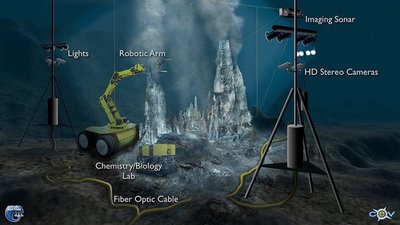May 25, 2006
Proposed budget includes money for cabled observatory off Washington
With $150 million in President Bush’s proposed budget to install a cabled seafloor observatory off Washington and Oregon, a planning session is being convened June 5 for UW faculty and departments to learn how they might take advantage of this new facility for earth and ocean research and education.
Local organizers of the NEPTUNE program based at the UW will update the UW community on recent developments during sessions from noon to 5 p.m., beginning with a lunch. Participants should register by sending e-mail to neptune@apl.washington.edu and should indicate if they will attend just the lunch or the full session, and if they wish to be on a mailing list for future updates.
“Prior meetings have identified groups of interested researchers on campus,” says John Delaney, professor of oceanographer and director of the NEPTUNE program. “During this meeting we hope to broaden and solidify those groups. As an outcome of this meeting we want to initiate the formation of expert groups who will take advantage of the opportunities implicit in this program to seek early funding for the development of innovative, long-term experiments or cutting edge educational approaches that will fully utilize the capabilities of the capabilities of the regional cabled observatory.”
“Potential investigators are invited to propose experiments on the regional cable observatory system, to NSF, or to any other agency or foundation that supports cutting edge research or education using novel platforms. We are especially interested in working closely with researchers who have traditionally worked in the coastal-oceanography areas nearer shore.”
“We also hope to forge strong bonds with local industry groups to move this program forward on many fronts.”
The funding in Bush’s budget calls for installing a regional cabled observatory in the Northeast Pacific, one that is strongly patterned after the concept of NEPTUNE as it has been developed by UW faculty and their colleagues across the country and in Canada. The UW will be applying to be the implementing organization for the regional cabled observatory.
The $150 million would be over six years starting in 2007, according to Bush’s budget. The money is part of proposed funding of $310 million for the National Science Foundation’s Ocean Observatories Initiative and comes from funds specifically designated for the creation of powerful new research tools and infrastructure.
The funds in the proposed budget will be primarily used for infrastructure of the cabled observatory, according to William Wilcock, professor of oceanography and organizer of the June 5 meeting. In general, scientific experiments and widespread educational uses of the new facility will be covered from other sources both within NSF and outside.
Under the NEPTUNE concept of a cabled observatory, scientists on shore will use the Internet to direct instruments and robots remotely. A 2,500-kilometer (1,600-mile) cable able to supply power and carry instructions and data will encircle and cross the Juan de Fuca plate off the coast of Oregon, Washington and British Columbia. One of the Earth’s tectonic plates, the Juan de Fuca is a place rocked with quakes and volcanic eruptions, and a place where new seafloor is created.
The NEPTUNE ocean observatory will gather information on Earth and ocean phenomena from the tops of the waves to below the seabed and send it instantly back to land for use by scientists, teachers, policy makers and anyone who’s always wanted a telescope trained on the ocean depths, Earth’s own “inner space.”
More information about NEPTUNE is at http://www.neptune.washington.edu/.
Tag(s): John Delaney • Ocean Observatories Initiative • oceanography

